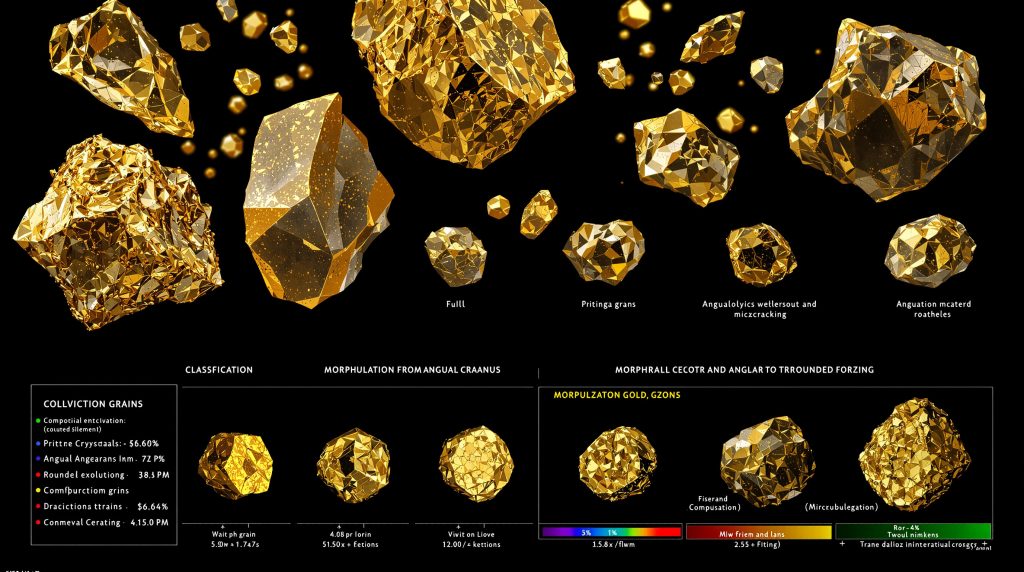What is Gold Grain Morphology Analysis?
Gold grain morphology analysis is a specialized technique in exploration geology that examines the physical and chemical characteristics of gold particles to reveal their origin, transport history, and depositional environment. This method serves as a critical bridge between microscopic observations and macroscale geological processes, offering valuable insights for mineral exploration importance.
At its core, this technique involves detailed examination of shape, surface features, and internal structures of individual gold particles collected from various sources. Modern analysis can detect features at remarkably small scales, with Scanning Electron Microscopy (SEM) achieving resolutions down to 1-5 nanometers for detailed surface examination (Goldstein et al., 2018).
In practical applications, gold grains typically range from 0.1 mm to several millimeters in placer deposits, with fine gold (<0.5 mm) being most common in environments farther from the original source (Hérail et al., 1990). This size variation itself becomes a valuable indicator of transport distance and depositional environment.
The Science Behind Gold Grain Analysis
Gold particles found in sediments, soils, and placer deposits contain encoded information about their geological journey. By studying their shape, surface texture, and internal structure, geologists can reconstruct the complex history of these tiny metallic messengers—from their formation in primary bedrock sources to their final resting places in secondary environments.
According to research published in peer-reviewed literature, gold grain morphology serves as a "fingerprint" of transport and weathering processes. The preservation of specific surface features depends on the resistance of gold to chemical weathering and its malleability during mechanical transport (Chapman et al., 2000).
Studies in glaciated terrains of Northern Canada have demonstrated that gold grain morphology can distinguish between glacially transported grains and those derived from local bedrock sources, with pristine grains indicating proximity to bedrock mineralization (McClenaghan and Cabri, 2011).
Key Parameters Examined
- Physical characteristics: Shape, size, roundness, surface texture
- Chemical composition: Gold content, trace element signatures
- Internal structures: Zoning patterns, inclusions, microstructures
- Surface features: Pitting, striations, flattening, microcracking
When conducting SEM analysis for gold grain morphology, researchers typically operate at specific parameters including accelerating voltage of 15-20 kV, working distance of 10-15 mm, and employ both secondary electron detectors for topographic details and backscattered electron detectors for compositional contrast (McClenaghan et al., 2011).
Why is Gold Grain Morphology Important for Exploration?
Gold grain morphology analysis has emerged as one of the most cost-effective and powerful tools in modern mineral exploration, particularly in regions where direct bedrock sampling is challenging or impossible.
Research by the Geological Survey of Canada emphasizes that in glaciated and covered terrains where bedrock exposure is limited to less than 5-10% of surface area, gold grain morphology becomes one of the few practical methods for tracing mineralization to source (McClenaghan, 2005). This becomes particularly critical in regions like the Canadian Shield or portions of West Africa where traditional exploration methods face significant limitations.
Tracing Gold to Its Source
The analysis helps geologists determine the proximity to primary gold deposits by examining grain characteristics. Transport distance indicators have been well-documented through research, with angular grains with pristine crystal faces typically found within 100m of their source, while sub-angular grains with minor rounding suggest transport distances of 100m-1km (Knight et al., 2013).
| Morphological Feature | Geological Interpretation | Exploration Significance |
|---|---|---|
| Angular, sharp-edged grains | Minimal transport, proximal source | Potential nearby primary deposit |
| Rounded, smooth grains | Extensive transport, distal source | Requires upstream tracing |
| Pristine crystal faces | Direct derivation from veins | Indicates minimal weathering |
| Flattened, deformed grains | Mechanical stress during transport | Suggests reworking in sedimentary systems |
Studies in the Birimian greenstone belts of West Africa (Ghana, Burkina Faso) have successfully used gold grain morphology to identify source deposits in deeply weathered terrains where traditional geophysical methods are less effective (Nude et al., 2012). These applications demonstrate the versatility of the technique across different geological settings.
Defining Exploration Targets
By mapping the distribution of gold grains with specific morphological characteristics across a drainage basin or glacial terrain, exploration teams can:
- Identify upstream source areas with higher probability of mineralization
- Prioritize drilling targets based on grain density and morphological trends
- Reduce exploration costs by focusing efforts on high-potential zones
- Distinguish between multiple gold sources within a single drainage system
As highly rounded and polished grains may indicate transport distances exceeding 10km in fluvial systems, identifying transitions from rounded to angular grains upstream can help pinpoint potential source zones with remarkable precision (Knight et al., 2013).
How Are Gold Grains Classified?
Gold grain morphology classification systems provide a standardized framework for categorizing particles based on their physical characteristics and inferred history.
Classification Based on Shape and Roundness
Gold grains are often classified using adaptation of the Powers (1953) roundness scale:
- Very angular: 0.0-0.17
- Angular: 0.17-0.25
- Sub-angular: 0.25-0.35
- Sub-rounded: 0.35-0.49
- Rounded: 0.49-0.70
- Well-rounded: 0.70-1.0
This quantitative approach allows for consistent comparison between different studies and regions, though simplified three-category systems are also commonly used in exploration applications.
Primary Classification Categories
- Pristine grains: Exhibit sharp, unmodified edges with minimal wear, indicating primary sources with limited transport
- Modified grains: Show partial rounding and surface alteration due to moderate transport
- Reshaped grains: Highly rounded and polished, signifying extensive reworking in secondary environments
A comprehensive classification scheme published by Chapman et al. recognizes that gold grain morphology reflects both primary characteristics inherited from the bedrock source and secondary modifications during transport and weathering. Their system integrates shape, surface texture, and compositional features into a unified classification framework (Chapman et al., 2000).
Surface Texture and Deformation Features
The microscopic examination of gold grain surfaces reveals distinctive patterns that reflect specific geological processes. Townley et al. (2003) identified four main surface texture categories:
- Hackly/crystalline: Irregular surfaces with crystal growth features
- Smooth/polished: Surfaces modified by mechanical abrasion
- Etched/corroded: Surfaces showing chemical dissolution
- Coated: Surfaces with secondary mineral precipitates
Studies comparing gold from glacial tills versus stream sediments show distinct morphological signatures. Glacial grains typically display irregular shapes, striations, and preserved angular fragments, while fluvial grains show progressive rounding, polishing, and flattening (Averill, 2001). These differences allow geologists to identify the dominant transport mechanism in complex landscapes.
What Methods Are Used in Gold Grain Morphology Studies?
A comprehensive gold grain morphology study involves multiple analytical techniques and methodological approaches.
According to guidelines published by the Geological Survey of Canada, effective gold grain morphology studies require integrated multi-technique approaches. The combination of optical microscopy for initial screening, SEM for detailed surface characterization, and electron microprobe for compositional analysis provides complementary datasets that enhance interpretation reliability (McClenaghan et al., 2011).
Field Sampling and Processing
The journey from field to laboratory follows a systematic process:
- Strategic sampling of sediments from stream beds, glacial tills, or soil horizons
- Gravity concentration through panning or specialized equipment
- Isolation of heavy mineral fractions
- Hand-picking of individual gold grains under microscopic examination
Recovery rates vary significantly between methods, with gold recovery efficiency by panning typically between 40-70% for grains >0.5mm, while heavy liquid separation can achieve >95% efficiency for properly sized samples (Clifton et al., 1969). These efficiency differences must be considered when designing sampling programs and interpreting results.
Advanced Analytical Techniques
Modern studies employ sophisticated technologies to extract maximum information:
-
Scanning Electron Microscopy (SEM): Reveals microscopic surface features and textures at high magnification
-
Electron Microprobe Analysis: Provides detailed elemental composition data under specific analytical conditions:
- Accelerating voltage: 20-25 kV
- Beam current: 20-40 nA
- Beam diameter: 1-5 μm for homogeneous areas
- Detection limits: Ag, Cu, Hg typically 100-500 ppm (Cabri et al., 1989)
-
Laser Ablation ICP-MS: Measures trace element signatures and isotopic compositions with the following typical parameters:
- Spot size: 20-50 μm
- Laser frequency: 5-10 Hz
- Energy density: 5-10 J/cm²
- Detection limits: Sub-ppm to ppb levels for trace elements (Sylvester, 2008)
-
3D reconstruction techniques: Creates three-dimensional models of grain morphology using SEM photogrammetry or micro-CT scanning
Recent developments include automated SEM-based mineral analysis systems (e.g., QEMSCAN, MLA) that can process and classify hundreds to thousands of particles, though gold-specific applications remain limited due to gold's low abundance and unique properties (Pirrie et al., 2004).
How Does Chemical Composition Enhance Morphological Analysis?
The integration of morphological examination with microchemical analysis—known as morphochemical analysis—significantly enhances the diagnostic power of gold grain studies.
Research demonstrates that trace element chemistry of gold grains provides deposit-type discrimination capabilities that complement morphological observations. The systematic variation in Ag, Cu, Hg, and other trace elements reflects different temperature-pressure conditions and fluid compositions during gold formation, allowing geologists to distinguish between multiple gold sources even when morphological features are ambiguous (Chapman and Mortensen, 2016).
Trace Element Fingerprinting
Gold typically contains trace amounts of other elements that can serve as geochemical signatures. Different deposit types show characteristic fineness ranges:
- Orogenic gold deposits: 850-950 fineness (15-5% Ag)
- Epithermal deposits: 600-850 fineness (40-15% Ag)
- Porphyry-related deposits: 700-900 fineness (30-10% Ag)
- VMS-related gold: 850-950 fineness (15-5% Ag)
These ranges, documented by Chapman et al. (2000), provide critical discriminating factors when attempting to identify the source deposit type.
The use of trace element discrimination diagrams enhances interpretative capabilities:
- Ag-Cu plots: distinguish porphyry vs. orogenic gold
- Ag-Hg plots: identify epithermal contributions
- Ag-Pb plots: separate magmatic from metamorphic sources
Internal Structure and Compositional Zoning
Gold grains frequently display internal heterogeneity that provides additional clues:
- Core-rim variations: Different gold content between interior and exterior portions
- Sharp compositional boundaries: May indicate dissolution-reprecipitation processes
- Gradational zoning: Suggests progressive chemical changes during formation or transport
- Inclusions of other minerals: Reveals association with specific host rocks or mineralization styles
Comprehensive studies of placer gold in the Klondike district, Yukon, have used compositional analysis to identify at least three distinct gold sources with different Ag contents and trace element signatures, demonstrating multiple mineralization events in the region's geological history (Knight et al., 1999).
What Can Gold Grain Morphology Tell Us About Transport History?
The journey of gold grains from source to sink is recorded in their physical characteristics, allowing geologists to reconstruct transport pathways and mechanisms.
Interpreting Transport Distance
The degree of modification in grain morphology correlates with transport distance. Research from fluvial systems indicates:
- 0-500m: minimal morphological change, pristine features preserved
- 500-2000m: initial rounding of sharp edges begins
- 2-10km: significant rounding, surface polishing evident
-
10km: well-rounded grains, extensive modification
Morphological Evolution During Transport:
As gold particles travel from their source, they undergo progressive changes in shape and texture. Angular fragments gradually transform into rounded grains through mechanical abrasion, while chemical processes simultaneously modify surface textures and sometimes internal composition.
Studies of gold transport in natural systems demonstrate that gold's high density (19.3 g/cm³) and malleability create unique transport characteristics compared to other sedimentary particles. Gold grains are preferentially deposited in low-energy environments and can be repeatedly remobilized during high-flow events, creating complex transport histories that may not follow simple downstream attenuation patterns (Giusti, 1986).
Environmental Indicators in Morphology
Different transport environments leave distinctive imprints on gold grains:
-
Fluvial transport: Progressive rounding, polishing, and flattening. Gold loses approximately 0.01-0.1% of mass per kilometer of fluvial transport (highly variable depending on grain size and transport energy) and can be flattened to thickness:width ratios of 1:10 or greater in high-energy environments (Youngson and Craw, 1999).
-
Glacial transport: Distinctive striations, gouges, and irregular deformation. Studies from glaciated shields demonstrate that gold transported by glaciers shows preservation of angular morphologies over long distances (>100 km), development of parallel striations and gouges, deformation without significant rounding, and association with host rock fragments (McClenaghan and Kjarsgaard, 2001).
-
Colluvial movement: Limited modification with partial edge rounding
-
Chemical weathering environments: Dissolution features and secondary precipitation textures
How Are Gold Grain Studies Applied in Different Geological Settings?
Gold grain morphology analysis has proven valuable across diverse geological contexts, each presenting unique challenges and opportunities.
Applications in Glaciated Terrains
In regions affected by glaciation, gold grain studies help overcome exploration challenges:
- Mapping dispersal trains from known or hidden mineralization
- Determining ice flow directions and transport distances
- Distinguishing between multiple glacial events and their associated mineral signatures
- Identifying potential source areas beneath thick glacial overburden
Approximately 10% of Earth's land surface is currently glaciated, with an additional ~20% of land surface affected by Pleistocene glaciation. In Canada, ~90% of the land surface has been glaciated, making gold grain morphology studies particularly valuable for mineral exploration in this region.
Applications in Tropical and Weathered Environments
In deeply weathered terrains, gold grain morphology provides insights into:
- Chemical weathering processes affecting primary deposits
- Formation mechanisms of lateritic and supergene gold enrichment
- Dispersion patterns in tropical drainage systems
- Preservation potential in different weathering profiles
Studies in the Birimian greenstone belts of West Africa have demonstrated that gold grains in tropical environments can develop distinctive dissolution features and reprecipitation textures that provide information about weathering intensity and paleoclimate conditions.
What Case Studies Demonstrate Successful Applications?
Numerous exploration programs have successfully employed gold grain morphology analysis to discover new mineral resources.
Case Study: Tracing Placer Gold to Bedrock Sources
In many regions worldwide, detailed morphological studies of placer gold have led to the discovery of previously unknown primary deposits:
- Systematic sampling and morphological analysis of stream sediments
- Progressive changes in grain characteristics tracked upstream
- Identification of transition zones where pristine grains appear
- Targeted drilling in areas with high concentrations of unmodified grains
The Klondike District in Yukon Territory, Canada provides a classic example where gold grain morphology studies helped identify multiple bedrock sources for the famous placer deposits. By tracking changes in grain shape, surface texture, and compositional features, researchers were able to distinguish between different gold populations and trace them back to specific structural zones in the surrounding metamorphic terrain.
Case Study: Exploration in Covered Terrains
Where conventional exploration methods are limited by lack of outcrop, gold grain studies have proven particularly valuable:
- Integration of gold grain morphology with regional geological framework
- Correlation of grain characteristics with geophysical anomalies
- Development of conceptual models linking observed patterns to hidden mineralization
- Successful drill targeting based on morphological vectors
In the glaciated terrains of Finland and Sweden, gold grain morphology analysis has been systematically employed to locate bedrock gold deposits beneath thick till cover. By carefully mapping the distribution of grain types across regional sampling grids, exploration teams identified distinct dispersal trains leading back to previously unknown mineralized zones.
What Are the Future Directions in Gold Grain Morphology Research?
The field continues to evolve with technological advances and new methodological approaches.
Emerging Technologies and Approaches
Recent developments are expanding the capabilities of gold grain morphology analysis:
- Automated SEM imaging and analysis: Enabling rapid processing of large sample sets
- Machine learning algorithms: Improving classification and interpretation of morphological features
- Isotopic analysis: Adding new dimensions to provenance determination
- Integration with big data approaches: Combining morphological data with regional geological datasets
Advanced image analysis software can now process thousands of SEM images to automatically classify gold grains based on multiple morphological parameters, greatly increasing efficiency and reducing subjective interpretation errors. These systems can identify subtle patterns that might be missed by human observers, particularly when dealing with mixed populations from complex source areas.
Integration with Broader Exploration Frameworks
Modern mineral exploration increasingly incorporates gold grain morphology within comprehensive targeting strategies:
- Multi-parameter indicator mineral studies: Combining gold with other pathfinder minerals
- Integrated geochemical mapping: Correlating grain morphology with soil and stream sediment geochemistry
- Predictive modeling: Using morphological trends to forecast probability of mineralization
The incorporation of AI in mining innovation promises to transform the field by enabling more rapid processing of large datasets, identification of subtle patterns, and integration with other exploration parameters. Early applications have shown potential for automated classification of grain types and prediction of source characteristics based on morphological features.
What Are the Practical Considerations for Gold Grain Sampling?
Effective gold grain morphology studies require careful attention to sampling methodology and quality control.
Sampling Strategies for Different Environments
Sampling approaches must be tailored to specific geological settings:
- Stream sediments: Strategic sampling of active channels, bars, and trap sites
- Glacial till: Consideration of ice flow direction and sampling depth
- Residual soils: Attention to soil horizon development and weathering profiles
- Beach and shoreline environments: Understanding of coastal processes and concentration mechanisms
The selection of appropriate sampling sites requires understanding of local sedimentary processes and potential trap sites where heavy minerals naturally concentrate. In stream environments, these include:
- Inside bends where flow velocity decreases
- Natural riffle structures where density sorting occurs
- Behind large boulders or other flow obstructions
- In cracks and crevices of bedrock channels
Sample Processing and Recovery Techniques
The recovery of representative gold grain populations demands appropriate methods:
- Field concentration: Panning, sluicing, or portable processing equipment
- Laboratory separation: Heavy liquid separation, magnetic separation, or specialized concentration tables
- Grain picking protocols: Systematic approaches to ensure unbiased selection
- Documentation standards: Consistent recording of morphological characteristics
Quality control procedures should include blind duplicate samples, processing of known reference materials, and regular calibration of analytical instruments to ensure reliable, reproducible results.
FAQ: Gold Grain Morphology Analysis
How does gold grain morphology differ from other indicator mineral methods?
Gold grain morphology analysis focuses specifically on gold particles, examining their physical and chemical characteristics to determine source and transport history. Unlike broader indicator mineral surveys that look for various minerals associated with potential deposits, gold grain studies directly analyze the target commodity itself, providing immediate relevance to gold exploration. The distinctive properties of gold—its malleability, resistance to chemical weathering, and characteristic trace element signatures—make it particularly informative compared to other indicator minerals.
What is the minimum sample size needed for reliable gold grain morphology analysis?
Effective gold grain morphology studies typically require processing sufficient sediment volume to recover at least 10-20 gold grains per sample site, though larger populations (50+ grains) provide more statistically robust results. In gold-poor areas, this may necessitate processing 10-20 kg of sediment or more, while in enriched environments, smaller samples may suffice. The required sample size varies with the geological setting, transport mechanism, and concentration of gold in the source area.
Can gold grain morphology analysis distinguish between different types of gold deposits?
Yes, gold grain morphology analysis can often differentiate between various deposit types based on distinctive characteristics. For example, epithermal deposits typically produce gold with specific trace element signatures (Ag, Hg) and textural features, while orogenic gold systems produce grains with different compositional profiles and inclusion patterns. When combined with microchemical analysis, these morphological indicators can help identify the style of mineralization in the source area.
How does climate affect gold grain morphology and transport patterns?
Climate significantly influences gold grain morphology through its impact on weathering processes and transport mechanisms. In tropical environments, intense chemical weathering can produce distinctive dissolution features and secondary gold precipitation, while in glacial regions, mechanical processes dominate grain modification. Seasonal variations in stream flow, freeze-thaw cycles, and biological activity also affect how gold grains are transported and modified in different climatic settings.
The Value of Gold Grain Morphology in Modern Exploration
Gold grain morphology analysis represents a powerful tool that transforms microscopic particles into macroscopic exploration vectors. By decoding the information preserved in these tiny geological messengers, exploration geologists can reconstruct complex dispersion patterns, identify promising source areas, and target concealed mineralization with greater precision.
The integration of traditional morphological examination with advanced analytical techniques has elevated this approach from a descriptive science to a sophisticated exploration methodology. As technology continues to advance, the diagnostic power of gold grain studies will likely increase further, cementing its place as an essential component of modern gold exploration strategies.
In essence, gold grain morphology analysis bridges the gap between the visible and invisible aspects of gold mineralization, allowing geologists to see beyond surface expressions and develop three-dimensional models of gold dispersion systems. This capability is particularly valuable in today's exploration landscape, where easily discovered deposits have largely been found, and the future of gold deposit analysis and gold exploration drill results interpretation lies increasingly in concealed or deeply weathered terrains.
Further Exploration:
Readers interested in learning more about gold grain morphology analysis can also explore related educational content on YouTube, where various geology channels offer visual demonstrations of sampling techniques and microscopic examination of gold grains from different environments.
Ready to Find the Next Major Gold Discovery?
Discovery Alert's proprietary Discovery IQ model instantly notifies investors of significant gold and mineral discoveries on the ASX, transforming complex geological data into actionable investment opportunities. Explore how historic discoveries have generated substantial returns for early investors by visiting the dedicated discoveries page and position yourself ahead of the market.




